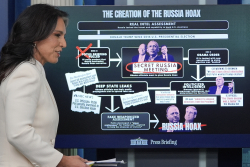Lt. Col. Pete Ellis’ “Operations Plan 712” was an extraordinary and prescient report—serving as the basis for what became the American amphibious juggernaut of World War II.
This is the first article of a two-part series examining America’s past and present Expeditionary Advanced Base Doctrine. Part 2 will be released next week.
“The US Marine Corps is developing and implementing its Expeditionary Advanced Base Doctrine to support US Navy and air operations in the Southwest Pacific Ocean.” That statement accurately describes an aspect of the 2025 Indo-Pacific strategic situation. It also described—minus the word “Expeditionary”—the USMC’s doctrinal work from 100 years ago, when America faced a rising and aggressive power in the Pacific Ocean.
The United States acquired Guam and the Philippines after victory in the Spanish-American War. Defending those new possessions naturally fell to the US Navy, though the Army maintained a significant presence in the Philippines. Neither service needed to look far to identify the most likely threat. Imperial Japan was an emerging world power, as evidenced by its shocking victory over Russia in 1904-1905 during the Russo-Japanese War—during which it notably mauled the Russian Navy during the Battle of Tsushima Strait.
The Navy began fortifying its Far East outposts, but the 1921 Washington Naval Conference forbade further work, leaving the Philippines and Guam mostly defenseless. The Navy and Army both quietly conceded that neither possession could be adequately defended against a determined Japanese invasion effort.
The Roots of America’s Advanced Base Doctrine
Admiral George Dewey had promoted the nascent Advanced Base program in 1905, noting that any Western Pacific campaign would require land-based support via fleet coaling, repair, and resupply stations. Marine Corps Major Dion Williams furthered this idea a year later using as an example the Japanese advanced base at Masampho, Korea during its 1905 blockade of the Russian military at Port Arthur.
Japan had been granted the Central Pacific’s so-called “Mandated Islands,” formerly possessions of Germany, after the First World War. The Navy’s “War Plan Orange” had long envisioned American ships transiting the Pacific before forcing a major fleet action on the Imperial Japanese Navy somewhere in the Philippine Sea. But with Japanese control of the Marshall, Caroline, and Mariana Islands, that transit route was now blocked by the presumed enemy.
The real visionary work on Advanced Base Doctrine came in 1921 from a brilliant Marine lieutenant colonel named Earl “Pete” Ellis. The Marine Corps was in dire danger of being absorbed into the Army after serving on the First World War’s Western Front and deploying to low-intensity Central American guerilla wars. Commandant John A. Lejeune, looking for a distinct role for the Corps and aware of War Plan Orange, commissioned Ellis to fully explore the role of supporting the fleet as it crossed a suddenly more hostile Pacific.
Ellis foresaw the Japanese strategy of using the island groups as a layered defense. He correctly assumed that Tokyo would attempt to bleed American naval power using land-based air power and submarines from strategic defensive positions. The goal was to weaken the US Navy before the final showdown that they, too, expected. Indeed, the Japanese moves of late 1941 and early 1942, prior to the decisive Battle of Midway, were aimed at expanding and further strengthening this defensive ring.
After seven manic months, Ellis completed the classic Operations Plan 712, Advanced Base Operations in Micronesia. This extraordinary and prescient report served as the basis for what became the American amphibious juggernaut of World War II. It discussed how the Marines would have to seize and defend island bases to support the fleet as it crossed the Pacific. But more importantly, it showed how they would do it.
Ellis worked out the basic doctrine, along with troop, equipment, training, and support requirements, and shrewdly predicted how the Japanese would defend their island territories. He incorporated air support, organizational structures, logistics, and naval gunfire. Lejeune adopted the report in its entirety, and Advanced Base Operations in Micronesia eventually evolved into the Marine Corps’ 1934 Tentative Manual for Landing Operations and, finally, the Navy’s FTP 167, Landing Operations Doctrine, the wartime American amphibious manual.
Pete Ellis’ Legacy Lives on in the Pacific Today
Pete Ellis died in 1923, killed by his extreme alcoholism while on a supposed “secret mission” to reconnoiter the Japanese mandate islands. This was no coincidence: Japanese authorities quickly spotted his overt sketching of beaches and approaches and, knowing his weakness, kept him well-supplied with whiskey and beer.
But Ellis’ professional legacy remains untarnished. The Pacific War, particularly the American Central Pacific offensive and individual operations, played out very closely to how he envisioned it. Furthermore, his work was crucial to American and Allied amphibious capability in all theaters.
A lecture hall at Marine Corps University is named for Ellis, and a bust of him adorns the entrance hall. Quantico’s Alfred M. Gray Marine Corps Research Center contains a display case dedicated to Ellis. Though less well-known, Ellis published numerous articles for the Marine Corps Gazette, including a 1912 piece on Advanced Base Doctrine and 1921’s Bush Brigades, a counterinsurgency piece based on his experience in the Philippines that still holds up today.
Ellis is the foremost amphibious warfare theorist, and his work still influences American amphibious and Advanced Base Doctrine today.
About the Author: William Lawson
William Lawson is a military historian focusing on World War II and 20th century conflicts and the American Civil War. His specialty is operational level warfare, especially American amphibious doctrine. He writes on history, politics, and firearms for multiple publications and historical journals. He serves on the editorial advisory board for the Saber & Scroll Journal and Military History Chronicles and is a member of the Society for Military History and the American Historical Association. Lawson is based in Virginia.
Image: Wikimedia Commons.

















